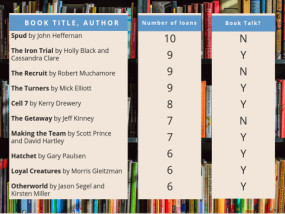- Your School Type
- Solutions
- Resources
- Blog
- Events
- More
- Contact Us
- Book a Demo
- Get a Quote
_-_28de80_-_b390c85b96fec1c934172cde98b315bc007f47dd.jpg)
We’re pleased to present this guest post by Liz Derouet – reader, reviewer, blogger, and Head of Library and Information Services at Toowoomba Grammar School in Queensland, Australia.
Working in school libraries has enabled Liz to keep up to date with what young people read and to pass on her great love of literature in a variety of ways. She has been reviewing children’s and young adult (YA) literature for almost 20 years and currently reviews for Magpies Magazine and Reading Time. Liz has Masters degrees in Teacher Librarianship and Children’s Literature, and has written and taught online courses for the University of Southern Queensland. She was the Queensland Judge for the Children’s Book Council of Australia Book of the Year Awards in 2007 and 2008. In this article, Liz shares how she makes use of the reporting function in Oliver v5 to improve school library services.
Periodically throughout the year I take a look at the Top 100 Resources borrowed by our students. These useful reports can be found under Circulation, in Usage with Search Criteria. This facility enables me to search for loans within a specific period of time, borrowed by a particular group of students and from particular sections of our library. The areas I choose are fiction, manga, graphic novel and non-fiction, as these areas are those borrowed from mostly by our students for their discretionary needs. We have a large magazine selection, however our students rarely borrow from here, instead preferring to read the magazines in the library, in small groups.
The information is used for a number of purposes. Firstly, I make this a focus of my newsletter article at the end of each semester. This not only gives readers, mostly parents, an idea of what their boys are reading, but also gives them ideas for gifts for their sons and other boys the same age. What better recommendation than from the age group you are buying for? I also use these lists for publications to give to visitors, prospective families, and existing students and their families on special days of celebration where we receive visitors through the library.
The information provides valuable insight to me as librarian. Firstly, it gives me an indication of the success of book talks. I am lucky to have each Year 7 and 8 class for a reading lesson each fortnight. At the beginning of each lesson I give a book talk. I have researched and written about book talks before, and know the impact they can have. A report of the Top 100 Resources borrowed by these year levels last semester showed that out of the top ten books borrowed, seven had featured in book talks. I take that as a success!

Looking at the reading habits of the older students, it is obvious they read for more practical purposes, that is, for information. From the top 50 items borrowed by Year 11 and 12 students, 17 were non-fiction. This decreased as the ages decreased, with Year 9 and 10 borrowing 9 items, and Year 7 and 8 borrowing 6 items. This reflects research completed by Love and Hamston (2001) that shows as boys become older and their reading becomes more specialised, their motives for reading non-fiction become more pragmatic. The reports also confirm my anecdotal findings that as our students progress through the upper grades at secondary school, their time for recreational reading of fiction becomes less with the many commitments they face.
Reference:
Love, K., & Hamston, J. (2001). Out of the mouths of boys: A profile of boys committed to reading. The Australian Journal of Language and Literacy, 24(1), 31-48. Retrieved from https://search-informit-com-au.ezproxy.slq.qld.gov.au/documentSummary;dn=204778910142494;res=IELAPA
• In part one of this two part series, learn how Stefanie Young, Literacy Learning Specialist at a special needs school, is overcoming the barriers to reading engagement.
• In part two of the series, Stefanie shares how she has addressed the barriers to reading books independently, and is providing access to popular, age equivalent titles.
• Trevanna Cooper, CBC Fremantle’s Teacher Librarian, describes how the college library promotes innovative thinking and helps students avoid research overwhelm with Softlink’s information curating tool, LearnPath.
Editor’s note: This post was originally published September 2018 and has been updated for freshness, relevance, and accuracy in August 2020.